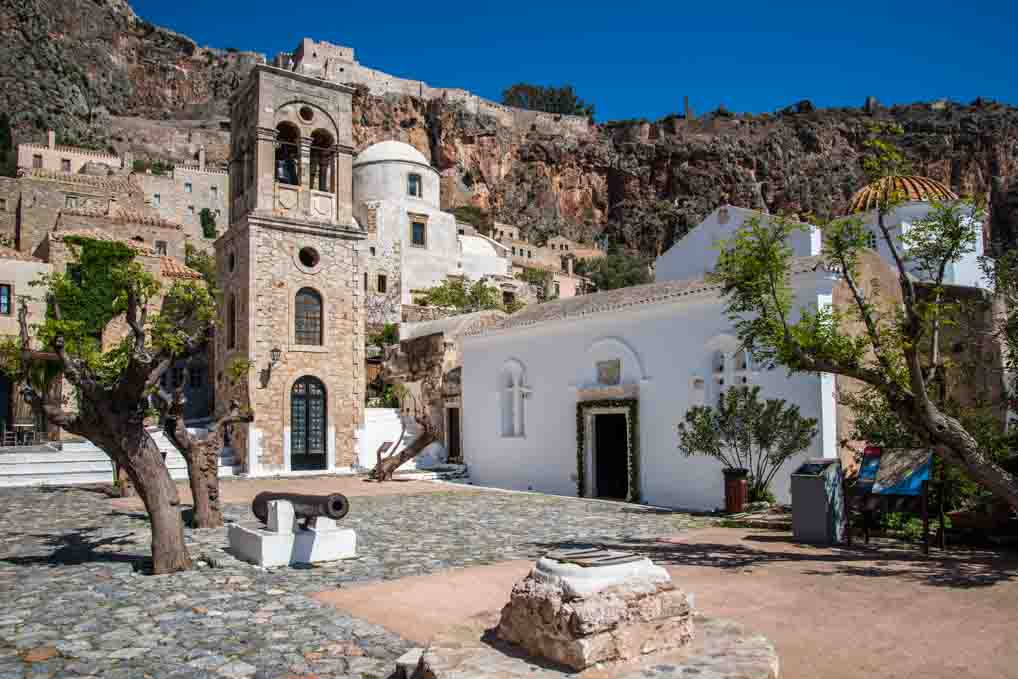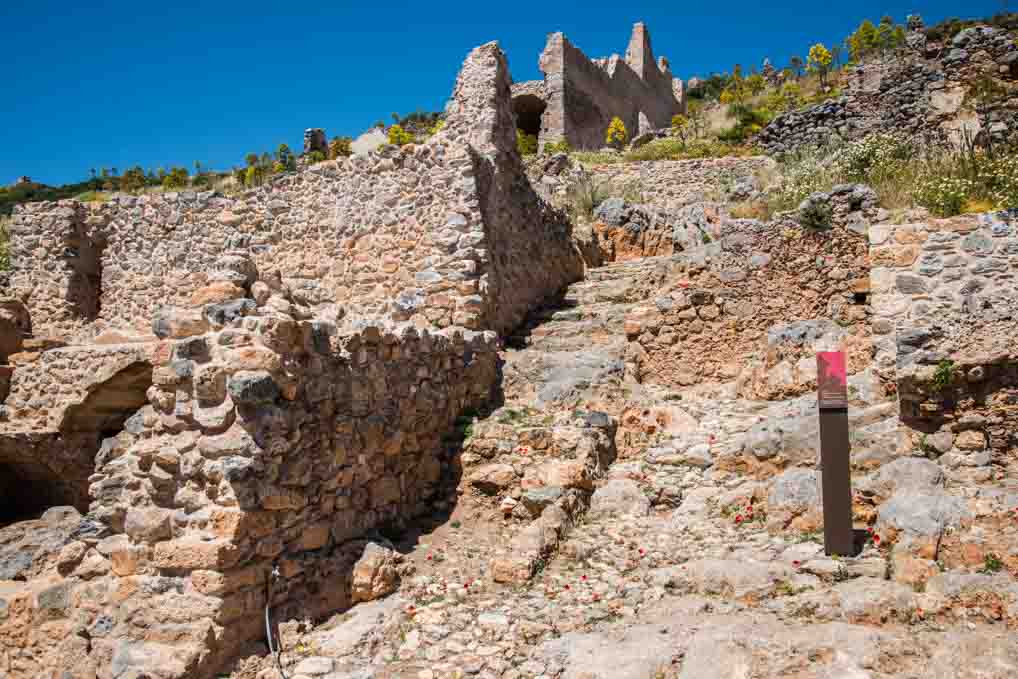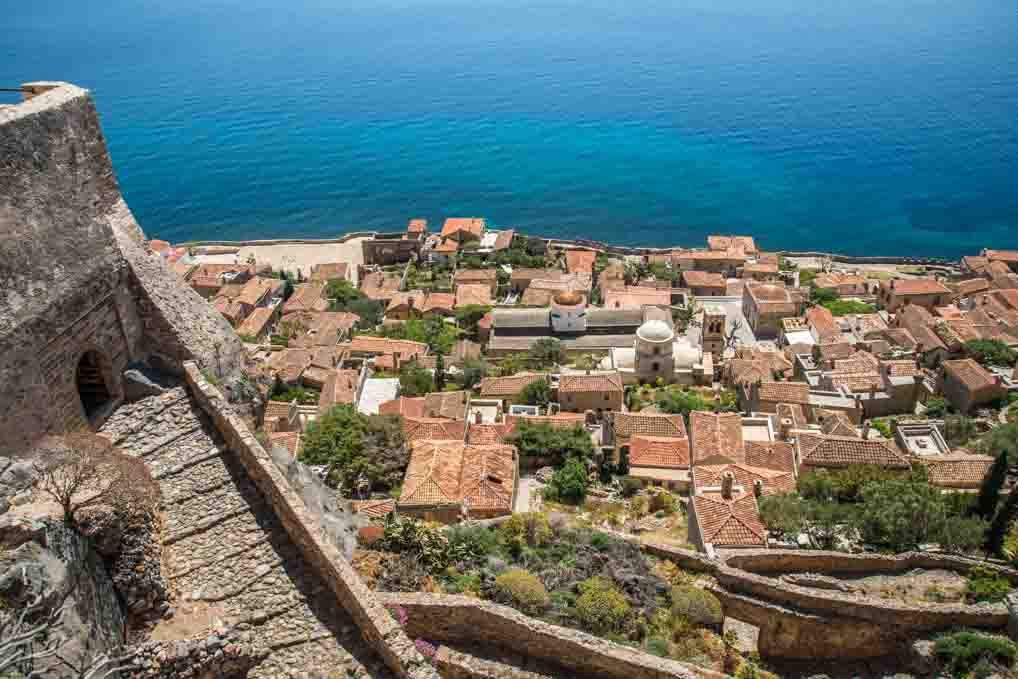Basil has only moved one yard from this time yesterday, but his tachometer says he’s travelled 12.6 miles. There’s the riddle for you!
Well it’s an easy one to resolve. We visited Monemvasia today, but we liked our wildcamping spot on the beach so much we’ve come back. Not just to the same beach but the very same spot amongst the shade of the pines – but one yard further back.
Last night we slept like logs – no dogs, no Scops Owl – until 3am, when Mabel started pacing up and down making us think she needed to go out. Up I got, on with my clothes, on with my head torch and out in the darkness with Mabel. Then back to bed, only to be woken at 4am, with Melek snuffling about and I went through the whole palaver all over again. Thanks dogs!
Team Basil finally woke up to the sound of waves gently lapping on “our” beach and after a quick breakfast of Greek yoghurt, fruit and muesli (we’re a healthy lot), it was off to Monemvasia – which was visible across the sea from Basil’s window, but was six miles away by road.

Monemvasia from “our beach”
If you read yesterday’s blog about Mistras, the history of Monemvasia is much the same. It was essentially the main port for Byzantine’s Peloponnese possessions. Built on an island, which rears almost 800 feet vertically out of the Adriatic, it has a small lower town, which is not visible from land, built on the sea facing side of the island and an upper town, which is surrounded by impenetrable cliffs. It only ever fell to attackers when the upper town was finally starved out. The last time this happened was in the Greek War of Independence. In 1821 the Ottoman Turks were reduced to eating rats before they finally surrendered and were then promptly massacred.
When we arrived across the modern causeway on the island I demonstrated my growing confidence in manoeuvring Basil by executing, though I say it myself, a nifty bit of parallel parking to access a parking spot that initially looked far too small for Basil’s big bones.

Lower Town walls with cliffs in the background
We walked the short distance to the gates of the old town. Our guide books describe the lower town as partly restored, but from what we could see it has all now been totally restored. The entrance and roads are too narrow for vehicles and so wandering through the cobbled streets is a peaceful experience, with tourist’s bags being carried to and from hotels by wheelbarrow.

Main Street
There is one main street which meanders roughly through the midline between sea facing lower walls and the cliffs. There are a few tourist tat shops and restaurants, but all in the best possible taste. Small streets run parallel to the main thoroughfare, with tiny alleys linking them all together. There is a small central square which is faced, on one side, by a Greek Orthodox church, which our books say is the largest in Southern Greece. It differed from most of the churches we have visited in Greece, because it is active and completely restored inside. There were the usual stunning gold leaf icons, which reminded me, for obvious reasons, of the churches we had visited in Russia, three years ago.

Alter Screen

Main Square
When we had finished exploring the lower town, and Melek had finished embarrassingly marking his territory in the clean neat streets, we started the climb to the upper town. It’s a 700 foot ascent, but the thoughtful Byzantines, no doubt aware of the unfit tourists that would visit their stronghold 600 years in the future, had built a walkway that zig zagged up the side of the cliffs, making the climb in the hot sun reasonably pleasant.

Upper Town
The upper town is a contrast to the lower town. Apart from the defensive walls and one or two partly restored buildings, it is completely in ruins. A few excavated cannon balls are displayed at various locations as a reminder of its military past. It was apparently much bigger than the lower town in its heyday, but now only the footings of the building are visible. The climb was worth it primarily for the view it gives you over the lower town and the surrounding coast.

Entrance to Upper Town on the left with lower town below
The Byzantines had not been quite so thoughtful in their choice of cobblestone as we discovered on our descent. Over time they have been polished smooth and become quite slippery and as a result the descent took longer than the ascent.
On our return to Basil we had a quick discussion on where to spend the night and those in the team able to vote unanimously chose the same wildcamping spot on the beautiful beach we had stayed the previous night.
We retraced our steps to the beach and the same location was still available and so we took it. After a quick lunch it was down to the beach, where Sarah jerry rigged some shade for the dogs so we could read and soak up the sun for longer than yesterday. It’s a tough life, but somebody’s got to live it!
